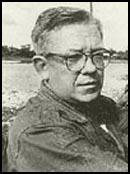Homer Bigart

Homer Bigart worked for the New York Tribune during the Second World War. He was one of the eight war correspondents selected to fly with the United States Air Force on bombing missions over Germany. This group became known as the Writing 69th.
After a week's high-altitude aircrew training in England he flew his first mission in a B-17 Flying Fortress on 26th February 1943. One of the journalists, Robert Post, was killed when his aircraft was shot down during the mission.
Bigart also reported on the Korean War and the Vietnam War. Bigart, who later joined the New York Times, twice won the Pulitzer Prize for journalism during his career. One critic has argued: "Bigart's tough, skeptical reporting and his lean, muscular prose set the benchmark for a younger generation of reporters, and helped to shape the critical brand of coverage that came to define the journalism of the late 1960s and 70s."
Homer Bigart died in 1991.
Primary Sources
(1) Homer Bigart was one of eight war correspondents selected to fly with the United States Air Force. He reported on his first flying mission to Germany in the New York Tribune on 27th February 1943.
Our target was Wilhelmshaven. We struck at Fuehrer Adolf Hitler's North Sea base from the southwest after stoogeing around over a particularly hot comer of the Third Reich for what seemed like a small eternity.
I could not quite make out our specific target for obliteration, the submarine pens, because at our altitude the installations along the Jade Busen (Jade Bay) seemed no larger than a pinhead. But the street pattern of the Prussian town stood out in perfect visibility and so did the large suburb of Rustringen, down the bay.
Our Fortress, "Old Soljer", piloted by Captain Lewis Elton Lyie of Pine Bluff, Ark., led the squadron. I was up in the nose
with the bombardier. Second Lieutenant Reinaldo J. Saiz of Segundo, Colo., and the navigator. First Lieutenant Otis Alien Hoyt of Dawn, Mo. We were lucky. Just before our arrival a heavy cloud formation cleared the northwest tip of Germany, drifting east and disclosing Wilhelmshaven to our bombsight.
And there was no Focke-Wulf on our tail when we started our bomb run. We had a good run and we were squarely over the town. I watched Saiz crouch lower over his sight. I heard him call "Bombs away."
Our salvo of 500-pounders plunged through the open bomb bay. From where I stood I could not see them land, but our ball turret gunner. Staff Sergeant Howard L. Nardine of Los Angeles, took a quick look back and saw fires and smoke.
Frankly, I wasn't so much interested in the target. What intrigued me was the action upstairs. Flak was bursting all around the squadron just ahead and to our left. The shells were exploding in nasty black puffs, leaving curious smoke trails of hour-glass shape.
Enemy fighters were darting in all directions. "Hoss" Lyie said there must have been 35. They were out for stragglers and they let us alone. There was a flak burst about 200 yards off our starboard wing, but that was the nearest we came to the casualty list.
(2) Homer Bigart, New York Tribune (16th August, 1945)
The radio tells us that the war is over but from where I sit it looks suspiciously like a rumor. A few minutes ago - at 1:32 a.m. - we fire-bombed Kumagaya, a small industrial city behind Tokyo near the northern edge of Kanto Plain. Peace was not official for the Japanese either, for they shot right back at us.
Other fires are raging at Isesaki, another city on the plain, and as we skirt the eastern base of Fujiyama Lieutenant General James Doolittle's B-29s, flying their first mission from the 8th Air Force base on Okinawa, arrive to put the finishing touches on Kumagaya.
I rode in the City of Saco (Maine), piloted by First Lieutenant Theodore J. Lamb, twenty-eight, of 103-21 Lefferts Blvd, Richmond Hill, Queens, New York. Like all the rest. Lamb's crew showed the strain of the last five days of the uneasy "truce" that kept Superforts grounded.
They had thought the war was over. They had passed most of the time around radios, hoping the President would make it official. They did not see that it made much difference whether Emperor Hirohito stayed in power. Had our propaganda not portrayed him as a puppet? Well, then, we could use him just as the war lords had done.
The 314th Bombardment Wing was alerted yesterday morning. At 2:20 p.m., pilots, bombardiers, navigators, radio men, and gunners trooped into the briefing shack to learn that the war was still on. Their target was to be apathetically small city of little obvious importance, and their commanding officer. Colonel Carl R. Storrie, of Denton, Texas, was at pains to convince them why Kumagaya, with a population of 49,000, had to be burned to the ground.
There were component parts factories of the Nakajima aircraft industry in the town, he said. Moreover, it was an important railway center.
No one wants to die in the closing moments of a war. The wing chaplain. Captain Benjamin Schmidke, of Springfield, Mo., asked the men to pray, and then the group commander jumped on the platform and cried: "This is the last mission. Make it the best we ever ran."
Colonel Storrie was to ride in one of the lead planes, dropping four 1,000-pound high explosives in the hope that the defenders of the town would take cover in buildings or underground and then be trapped by a box pattern of fire bombs to be dumped by eighty planes directly behind.
"We've got 'em on the one yard line. Let's push the ball over," the colonel exhorted his men. "This should be the final knockout blow of the war. Put your bombs on the target so that tomorrow the world will have peace."
